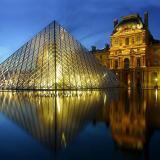
| |
| Things to do |
| Airfare |
| Hotels |
| Dining |
| Map |
| Visit Paric - France |
Paris is a close-knit and welcoming place with a pleasant climate. The Seine cuts across the city and two woods on either side offer a breath of fresh air. Indeed, Paris has been blessed by nature. It only takes barely two hours to cross the city on foot… Paris is not a sprawling capital. With a circumference of almost 55 km (including its two woods, Vincennes and Boulogne), it only comes in 113th place amongst municipalities in metropolitan France in terms of surface area. Located on the same latitude as Vancouver, Canada, Paris is in Western Europe. A city divided into the shape of a snail Paris is split into twenty unequally proportioned districts (arrondissements) in the shape of a snail. The largest, the 15th, alone covers almost 10% of the total surface area. The smallest, the 2nd, makes up hardly 1% of Paris' surface area. The city is at 30 metres above sea level. The highest point in Paris is located in the Rue du Télégraphe (20th arrondissement), reaching 148 metres. A mild climate Paris has a temperate climate with mild winters and relatively clement summers. The coldest recorded winter was in 1953-1954, when the thermometer dropped to -15°C and the hottest recorded temperature reached 38 °C during the heatwave in 2003. These temperatures are, however, exceptional. Average temperatures actually vary between 5 °C in winter and 20 °C in summer. July is the hottest month of the year and January the coldest. Spring, from March to May is the driest season. Other seasons get their fair share of rain. The geographical borders of the city seem to be traced by the 35-kilometre-long outer ring road. Yet one must not forget the two woodlands, Vincennes and Boulogne, which are on the edges of the city beyond this major road. Vincennes is located in the far east of Paris, and Boulogne in the far west. Acting as green lungs for the urban area, they are bigger than the first six arrondissements together. The other essential natural element in Paris is the river Seine. As the city's backbone, it snakes its way across the city over almost 13 km. The river, used as a special waterway for goods transport and tourism rides, is straddled by 37 bridges. The oldest surviving bridge in Paris, the Pont-Neuf, dates back to 1604. Everything there is to know about visiting Paris >
|
| Cities2Visit.com | ||
|
||

